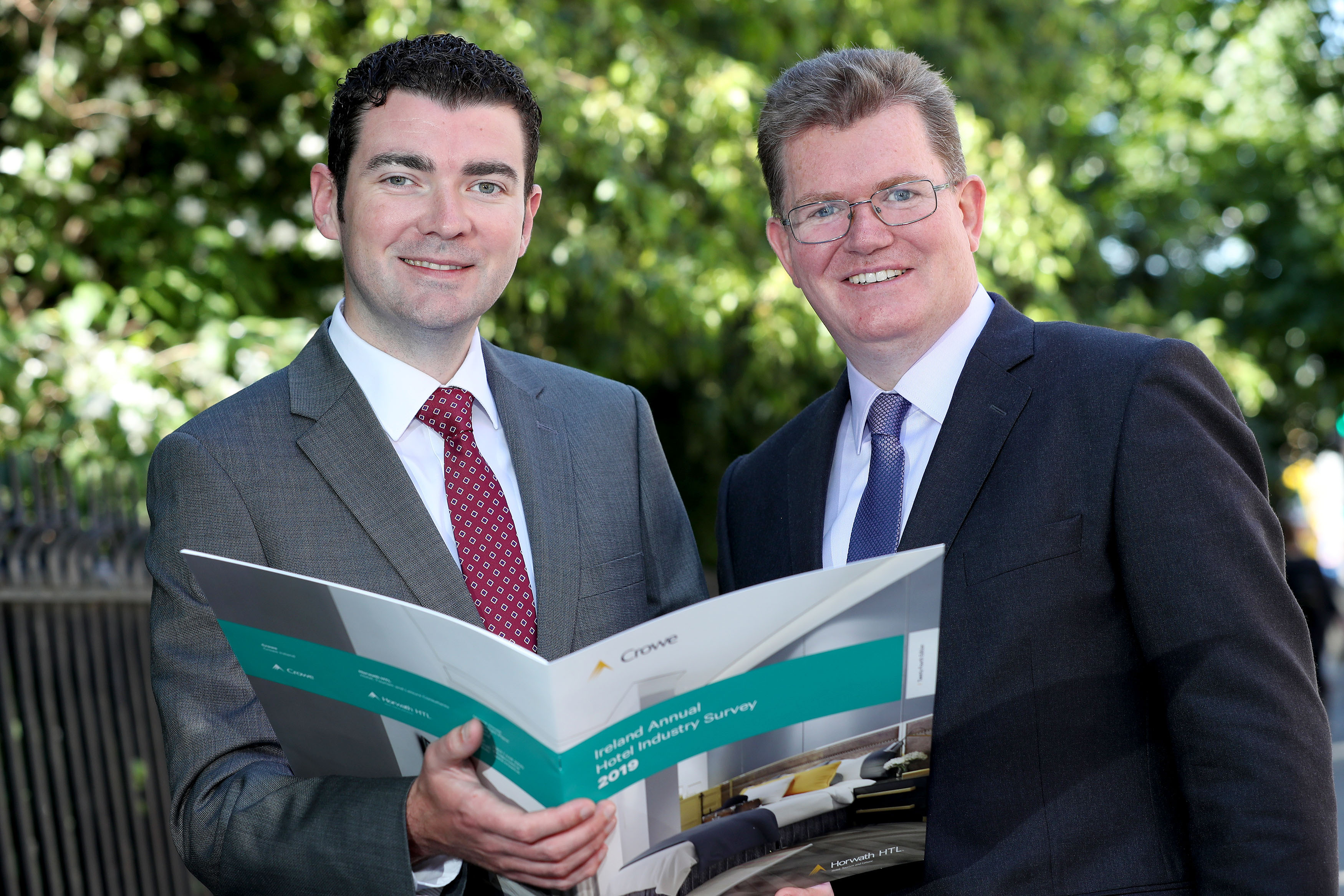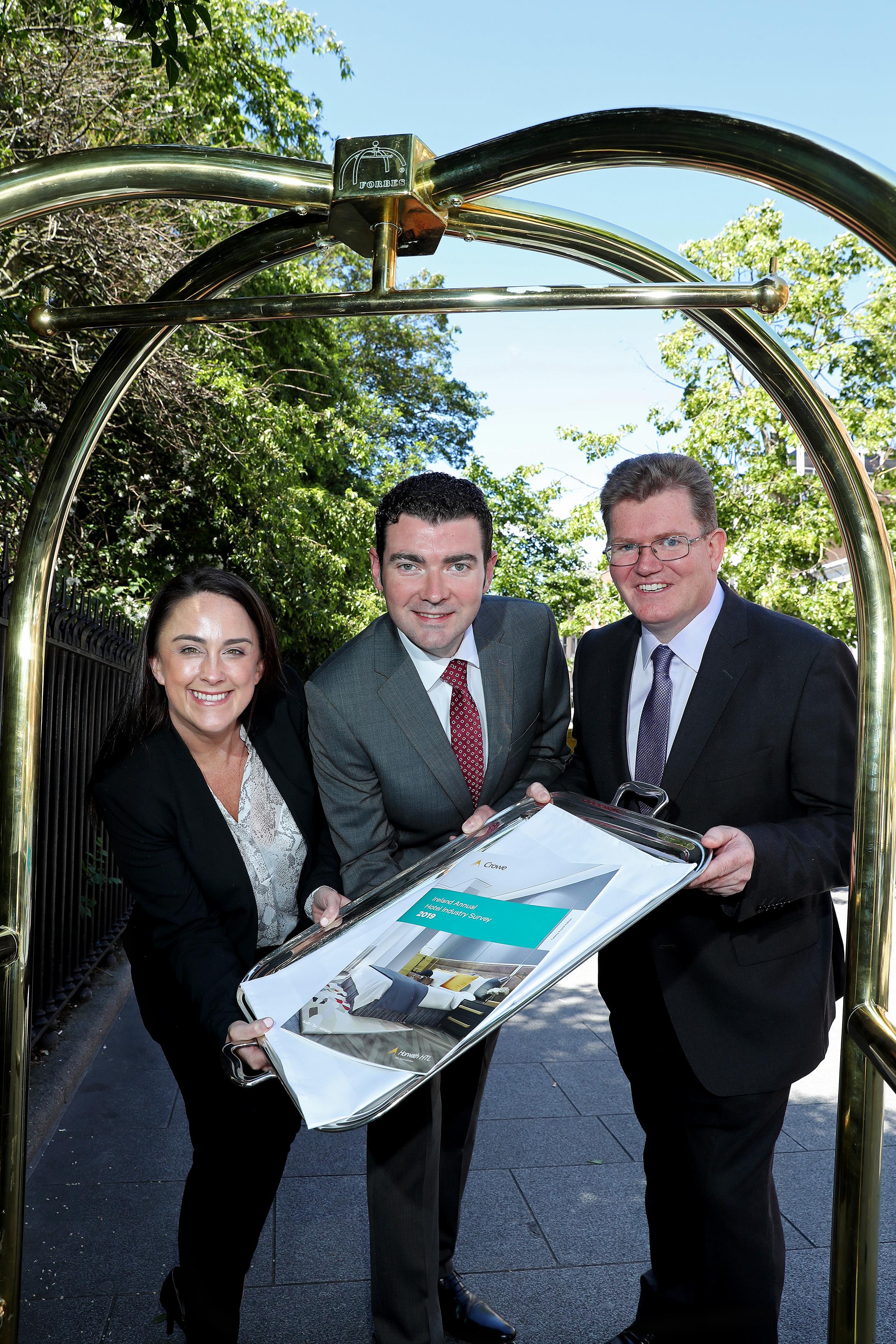
Crowe: Irish Hotel Sector at turning point with growth slowing as industry faces increased costs and threats of domestic slowdown, weakened sterling and ‘No Deal’ Brexit uncertainty
Crowe, Ireland’s leading accountancy practice and advisors to the Irish hotel sector, launched the 24th edition of Ireland’s most comprehensive annual analysis of the Irish hotel sector today. The Crowe Ireland Annual Hotel Survey, compiled from an analysis of Irish hotels’ 2018 accounts, shows that the sector experienced a positive year in 2018 with an eight-consecutive year of growth in turnover. Increased profit levels and average room rates have been recorded across all regions. Notwithstanding the strong performance by the sector, the report analysis by the report’s author Aiden Murphy, finds that 2018 marked a turning point for the industry as growth slows amid increased costs, threats of domestic slowdown, weakened sterling and Brexit uncertainty. The report concludes that the sector recorded the lowest level of profit growth in seven years at a rate of 7%, a significant decline from the 12.5% growth achieved in 2017.
The report also highlights that revenue from rooms and food sales grew at the lowest levels in five years, at 5.9% and 2.6% respectively, highlighting the slowdown in revenue growth as a result of increased competition for restaurant and events customers from non-hotel outlets and no increase in occupancy levels attained in 2018. These findings indicate that it is becoming harder for Irish hotels to increase profit levels despite reasonable revenue growth, as many costs are now increasing faster than the underlying growth in revenues.

Average Room Rates - Midlands and East region breaks €100 for the first time
With demand levels in 2018 remaining strong, the average nightly room rate nationally rose to €118.27, an increase of 6.3% or €7 from 2017. Rooms in Dublin hotels had an average rate of €145.82 some 6.5% higher than the price achieved in 2017, up almost €9. Outside of Dublin, hotel rooms in the Midlands and East and South West regions were both up over €7, rising to €105.51 and €107.80 respectively. This is the first time that hotels in the Midlands and East region broke the €100 mark. The average room rate of hotels in the Western Seaboard area achieved an increase of over €6 to €93.83 last year. The Western Seaboard area now remains the only region with an average nightly room rate below €100. 2018 occupancy levels of 75.1% were consistent with the previous year at 75.4%.
Visitor Numbers & Brexit - Two thirds of hotel guests from domestic and British visitors
The 2018 report highlighted the importance of the Irish Domestic market to the sector overall which accounted for 55% of all guests last year, as domestic trips were up 13.4% year on year to 10.9 million trips. This increase is driven by strong employment and high levels of disposable income currently being experienced. However, the report shows the industry’s scale of reliance on the domestic, Great Britain and Northern Ireland markets- with two thirds (68%) of Irish hotel business dependent on these markets. This kind of exposure to these markets poses a potential risk for the industry when the possible economic impacts of a hard Brexit, weakening sterling and knock on implications on the Irish economy, including a possible fall in disposable income are considered.
Brexit has already created a dampening of demand from sterling-source visitors. Since 2013, the market share of hotel guests from Northern Ireland and the UK has dropped by 25%, but to-date the surge in demand from US visitors has balanced this out. Since 2013, the North American market has doubled in its significance for Irish hotels as a source of business. In 2018, this market was critical in generating demand across the sector with 17% of all Irish hotel rooms now sold to North American guests. Visitor numbers to Ireland from North America in 2018 were over 2.38 million compared to 1.16 million in 2013, highlighting the growing importance of this market for the sector and the potential for this market to continue to grow steadily. The launch of Tourism Ireland’s Fill your Heart with Ireland campaign is a well-timed proactive approach to growing this market and mitigating the risks associated with possible declines in visitors from the domestic, Great Britain and Northern Ireland markets.
In this changing marketplace hotels particularly in the border counties, have found it more challenging to pick up replacement volumes from international markets and so have become more dependent on the domestic market. As a result, 2018 saw hotels in the Western Seaboard region experience different trading outcomes depending on their location with hotels in Clare, Galway and Mayo doing well as the Wild Atlantic Way continued to deliver but hotels in Donegal, Sligo and Leitrim faced challenges associated with weaker sterling. While hotels in the Midlands and East Region also had varied experiences with Cavan, Monaghan and Louth being hit by the Brexit impact whereas Dublin doorstep counties of Meath, Kildare and Wicklow performed well as the compression effect out of Dublin was even more pronounced in 2018.
Increasing Costs- Insurance costs increasing at twice the rate of hotel revenue growth
The 2019 report highlighted the areas of Payroll, Utilities and Insurance as major challenges to the industry with costs steadily growing higher than revenues. Utility costs grew at 8% compared to a growth in total revenues of 5% from the previous year. On average hotels are seeing a 10% increase in annual insurance premiums when compared to hotel revenues increasing at 5%. For the second year in a row, payroll costs have also increased at a greater rate than total revenues placing added pressure on hotels across the country. Increasing costs relate to salaries and benefits, higher turnover levels and increased training and development in a highly competitive arena. This will continue to be one of the most challenging areas facing Irish hoteliers in the coming years.
Luxury Hotels- Source of largest growth
Of all classifications, luxury/five-star hotels saw the biggest increase in the average room rate in 2018, with a €10 increase over 2017 figures, and an average room rate of €228.18. Over the last 5 years since 2013 the average room rate is up €80 for five-star hotels, €37 for four-star hotels, €32 for three-star hotels and €22 for two-star hotels. Following investment in the luxury hotel market and the international profile that a number of these properties have achieved, they are attracting a greater number of higher spending visitors who demand the highest quality service and product offering. As a result, Ireland now has a greater number of higher spending visitors than in 2013, many of which are from the US.

Commenting on this year’s survey, partner at Crowe, Aiden Murphy said: “The growth in the Irish hotel sector improved again in 2018, with increases in average room rates and profitability not just in the capital, but across all regions. However, 2018 has marked a turning point for the industry as the sector recorded the lowest level of profit growth in seven years, impacted by increased costs especially across payroll, utilities and insurance.”
Speaking about the outlook for 2019 Mr Murphy added: “Looking ahead to 2019, the 50% hike in VAT to 13.5% on rooms and food sales will make it a challenging year if the cost increases experienced in 2018 continue at a similar pace, making it difficult to pass on both the VAT increase and cost inflation to customers in terms of price increases. Rising costs such as insurance, payroll and utilities combined with the potential impact of a hard Brexit will make 2019 and future years more challenging for the sector.”
Commenting on the findings of the Crowe report, Brendan Griffin TD, Minister of State at the Department of Transport, Tourism and Sport said: “As the Irish economy continues to grow strongly, ensuring competitiveness is sustained is a top priority for Government. Capacity plays a part in determining our competitiveness, increased demand in recent years has led to increased room rates, particularly in the main tourist destinations and especially Dublin, as supply did not expand at the same pace. However, in 2018, nearly 2,000 more rooms came on stream, helping to alleviate some of the capacity pressures previously faced. This increase in supply should help to ease any concerns that our accommodation prices are becoming uncompetitive.”
“As the Brexit deadline draws closer, the industry, must be ready to face the challenges this will bring. Almost €8 million in additional funding was provided to the tourism agencies specifically to respond to the impact of Brexit in Budget 2019. While the tourism sector faces some significant challenges in 2019, I have no doubt that the sector is resilient and robust enough to meet these challenges and that we will continue to grow tourism in Ireland in a sustainable way into the future.”
For more information or for a copy of the Irish Hotel Survey, please log on to www.crowe.ie
